 Who: Thom Andersen is a Los Angeles-based filmmaker who has taught film composition at the California Institute of the Arts since 1987. His 2003 video essay, Los Angeles Plays Itself, focuses on how his city’s architecture and neighborhoods have been portrayed in Hollywood feature films. It proved a critically-popular work, winning the National Film Board of Canada Award for Best Documentary Feature at the 2003 Vancouver International Film Festival, and voted best documentary of 2004 in the Village Voice Film Critics’ Poll. Moreover, it has become a definitive analysis of the role films play in shaping our perceptions of the places and cultures we see up on screen — and helped inspire the creation of this website. In 2012, Andersen returned to the subject of architecture with Reconversão, about the work of Portuguese Pritzker Prize-winning architect Eduardo Souto de Moura. On September 20th 2013, to mark the 10th anniversary of Los Angeles Plays Itself, the American Cinematheque screened a remastered edition of the film at the Egyptian Theatre in Los Angeles. And on January 3rd 2014, New York City’s IFC Center headlines the East Coast 10th anniversary celebration with a 5-day run of screenings. Camera In The Sun spoke with Andersen about his opinion of Los Angeles architecture, Los Angeles films, the shift in where those films are being shot, and the meaning of the word “reconversion” within the works of Eduardo Souto de Moura.
Who: Thom Andersen is a Los Angeles-based filmmaker who has taught film composition at the California Institute of the Arts since 1987. His 2003 video essay, Los Angeles Plays Itself, focuses on how his city’s architecture and neighborhoods have been portrayed in Hollywood feature films. It proved a critically-popular work, winning the National Film Board of Canada Award for Best Documentary Feature at the 2003 Vancouver International Film Festival, and voted best documentary of 2004 in the Village Voice Film Critics’ Poll. Moreover, it has become a definitive analysis of the role films play in shaping our perceptions of the places and cultures we see up on screen — and helped inspire the creation of this website. In 2012, Andersen returned to the subject of architecture with Reconversão, about the work of Portuguese Pritzker Prize-winning architect Eduardo Souto de Moura. On September 20th 2013, to mark the 10th anniversary of Los Angeles Plays Itself, the American Cinematheque screened a remastered edition of the film at the Egyptian Theatre in Los Angeles. And on January 3rd 2014, New York City’s IFC Center headlines the East Coast 10th anniversary celebration with a 5-day run of screenings. Camera In The Sun spoke with Andersen about his opinion of Los Angeles architecture, Los Angeles films, the shift in where those films are being shot, and the meaning of the word “reconversion” within the works of Eduardo Souto de Moura.
What is new about the version of Los Angeles Plays Itself that screened at the Egyptian?
 It’s a remastered and slightly-reedited version. It’s not updated. That is, it won’t attempt to cover films that have appeared since the original was made. And it doesn’t include any films that were released after 2001. The text of the narrative is unchanged. But it has been reedited. For example, the intermission in the original occurred at 104 minutes. And now the intermission comes at 90 minutes. So instead of being a movie that was 104 minutes and 65 minutes — it’s a movie that’s 90 minutes, and then 80 minutes. Or, closer to being two movies. A double feature.
It’s a remastered and slightly-reedited version. It’s not updated. That is, it won’t attempt to cover films that have appeared since the original was made. And it doesn’t include any films that were released after 2001. The text of the narrative is unchanged. But it has been reedited. For example, the intermission in the original occurred at 104 minutes. And now the intermission comes at 90 minutes. So instead of being a movie that was 104 minutes and 65 minutes — it’s a movie that’s 90 minutes, and then 80 minutes. Or, closer to being two movies. A double feature.
The editing of the scenes didn’t change that much. Except, I thought some of the comedy scenes should be longer. I think that makes them funnier.
[In 2003,] DVDs had just started. So I used some DVDs, and there were some laser discs. But it was primarily VHS. When remastering the clips, instead of using VHS, I used DVD and Blu-ray. So the quality of the images will be much better. Also, instead of being 4:3 aspect ratio, now it will be in a 16:9 aspect ratio.
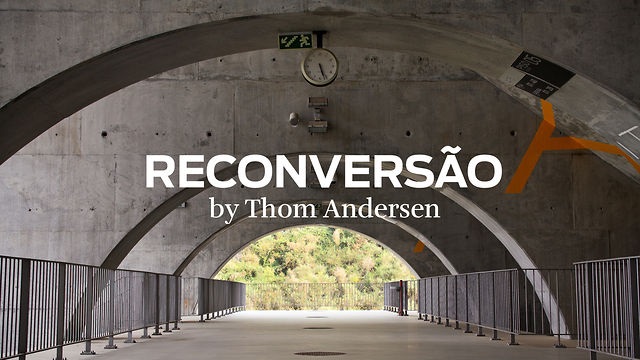
Has the critical acclaim for Los Angeles Plays Itself made funding your projects easier?
It hasn’t made it any easier to get funding for a film project. I did get small funding for one project, which was 10,000 euros to make Reconversão — or “reconversion” in English — about the architect Eduardo Souto de Moura. That is the last film I’ve completed, and was done in 2012. But 10,000 euros is not a lot to make a short feature film. The project was architecturally-themed. Although, that wasn’t a condition of getting the money. The only condition was that it was a film that had to be made in  northern Portugal, because the money was intended to help the economy of northern Portugal. So the money was spent there, but the choice of the subject was mine in that case.
northern Portugal, because the money was intended to help the economy of northern Portugal. So the money was spent there, but the choice of the subject was mine in that case.
Souto de Moura is an architect who had recently won the Pritzker Prize. It is the major international prize for architects, which brings a lot of recognition. But despite that, his work wasn’t well known. Because, with a few exceptions, almost all of it is in Portugal — and primarily in northern Portugal, which is where he practices. He’s from Porto, which is a major city in the north. So I thought he deserved to be better known.
Originally, the film was going to be titled “Ruins”, but there was already a rather famous Portuguese film with that title. So, “reconversion” is a word that doesn’t exist in English. It combines conversion, adaptation, restoration — all of those. So I think, in a way, the idea doesn’t exist. But a lot of [Souto de Moura’s] projects are reconversions. His buildings either incorporate an already-existing building, or restore and convert to another use an existing building.
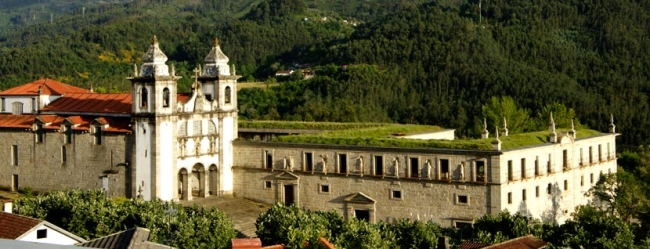
Most famously, he converted a monastery [Santa Maria do Bouro] dating from the 13th Century — which was then rebuilt and changed many times over the course of history — into a “Pousada”, which is a historic inn. There’s a chain of Pousadas in Portugal, which are run by the government, in which historic buildings are turned into hotels. [Santa Maria do Bouro] took a long time to do, and was completed in 1997. It was a very long project. But in that case, as he put it, it was a new building made from the existing stones. And it’s a very beautiful building.
Have you noticed a change in how Los Angeles is used in films during the past 10 years?
Well, one major change has simply been that there have been fewer films shot and set in Los Angeles as a result of other states luring away film productions through tax credits. Particularly Southern states like Louisiana and North Carolina. So films with a medium budget, and maybe modest aspirations, like The Replacement Killers in the ’90s or Cobra in the ’80s, probably wouldn’t be shot or set here anymore. These are films that use Los Angeles as a background, really.
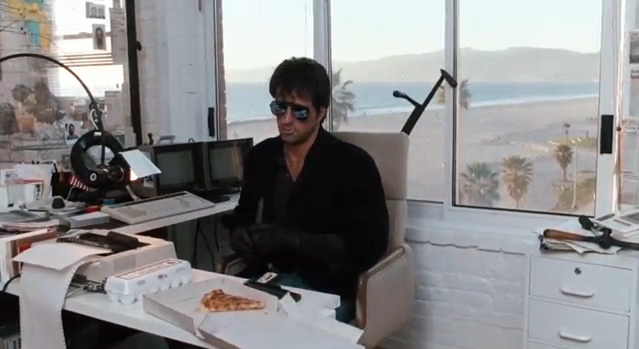
Even some films that are set in Los Angeles, or partially-set in Los Angeles, are being filmed elsewhere — such as Iron Man 3 or Battle Los Angeles. Although, in Battle Los Angeles there’s hardly any footage that is recognizably anywhere. It seems more like a desert in Iraq, than either Los Angeles or Louisiana. I think that’s the point of the film — that it’s a parable about the Iraq War, in which the U.S. Marines win this time. And there’s room for more heroism.
 So one result has been that Los Angeles films are, for the most part, low budget or lower-budget independent films. For example, the films have moved to the east of Los Angeles in their locales, because the filmmakers have moved to the east. They’re not as rich as Hollywood directors. So instead of living in Malibu or Beverly Hills or Bel Air, they live in Silver Lake or Echo Park or Highland Park. And so, their films are set there. The Kids Are All Right, for example, or Beginners or many others. And oftentimes, that means that the characters are younger, because the filmmakers are younger. So they’re facing different kinds of problems. But still, personally I find the kinds of problems they’re facing boring, and I find the characters boring. And in almost all of the films, they don’t bear any resemblance to the people I know. They’re very caught up in themselves, and they don’t talk about anything, except their personal relationships. I hope people do talk about other things — politics, arts, literature. That’s been my own experience of life.
So one result has been that Los Angeles films are, for the most part, low budget or lower-budget independent films. For example, the films have moved to the east of Los Angeles in their locales, because the filmmakers have moved to the east. They’re not as rich as Hollywood directors. So instead of living in Malibu or Beverly Hills or Bel Air, they live in Silver Lake or Echo Park or Highland Park. And so, their films are set there. The Kids Are All Right, for example, or Beginners or many others. And oftentimes, that means that the characters are younger, because the filmmakers are younger. So they’re facing different kinds of problems. But still, personally I find the kinds of problems they’re facing boring, and I find the characters boring. And in almost all of the films, they don’t bear any resemblance to the people I know. They’re very caught up in themselves, and they don’t talk about anything, except their personal relationships. I hope people do talk about other things — politics, arts, literature. That’s been my own experience of life.

What’s your take on the use of special effects in Los Angeles films?
With the new effects that were added to Blade Runner in the most recent version, I thought it was done well. It wasn’t obtrusive. It added something, I think. That’s a film that’s based on special effects in the first place, but with a different technology. It made sense to add some things, improve some things with current technology. Also, I appreciated their efforts to make the plot of the film a little more coherent. In Iron Man 2, on the other hand, I found most of the special effects distracting. You could say they were an attempt to hide the emptiness of the film. I think that’s often true. When I  saw Swordfish — which was released in 2001, and was filming when I was making some 16-millimeter shots of movie locations and movie productions in Los Angeles — I was struck by how much better the parts that were real looked than parts that were done with effects. That is, they really flew a giant helicopter with a bus hanging underneath it around downtown Los Angeles. And that reality made a difference. It’s kind of a strange film. Because you have the oil fields in Baldwin Hills filling in for oil hills in Texas. And most people know that Texas is flat. At least the part where the oil fields are is flat. And then it had Bunker Hill and the Bonaventure Hotel standing in for Washington DC. And everyone knows that there aren’t buildings like that in Washington D.C. But then there is the bank robbery that supposedly took place in downtown Pasadena in Ventura, which looked rather rural and small-townish to fill in for downtown Los Angeles. And it had a completely artificial backdrop for John Travolta’s house in the Hollywood Hills, which also looked completely fake. So it was this very strange amalgam of Los Angeles filling in for all kinds of different places. And then Ventura, which is close by, filling in for Los Angeles.
saw Swordfish — which was released in 2001, and was filming when I was making some 16-millimeter shots of movie locations and movie productions in Los Angeles — I was struck by how much better the parts that were real looked than parts that were done with effects. That is, they really flew a giant helicopter with a bus hanging underneath it around downtown Los Angeles. And that reality made a difference. It’s kind of a strange film. Because you have the oil fields in Baldwin Hills filling in for oil hills in Texas. And most people know that Texas is flat. At least the part where the oil fields are is flat. And then it had Bunker Hill and the Bonaventure Hotel standing in for Washington DC. And everyone knows that there aren’t buildings like that in Washington D.C. But then there is the bank robbery that supposedly took place in downtown Pasadena in Ventura, which looked rather rural and small-townish to fill in for downtown Los Angeles. And it had a completely artificial backdrop for John Travolta’s house in the Hollywood Hills, which also looked completely fake. So it was this very strange amalgam of Los Angeles filling in for all kinds of different places. And then Ventura, which is close by, filling in for Los Angeles.
Are there any neighborhoods highlighted in Los Angeles Plays Itself that no longer exist?
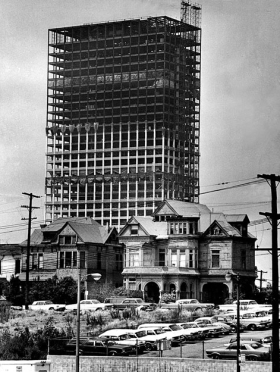 Well, the most famous dramatic example is the destruction of Bunker Hill as a residential neighborhood in Los Angeles. And I think those are crocodile tears. If it hadn’t been destroyed in the 1960s, it would have been destroyed sometime since. One part of that question is peoples feelings about downtown Los Angeles. Does Los Angeles have a downtown? The fact is it’s always had, and it has today, more of a downtown than almost any other city. It has had a downtown, which was both a civic center where all of the government buildings are concentrated — both the city government, and the greater Los Angeles County government — and it also has nearby its historic downtown. It has always been a highly-populated residential area. The clearing of Bunker Hill made possible making downtown also a central arts district. And people may differ about that, but I think it’s been a good thing that that exists. Maybe I have a personal stake in it, because for me it’s a lot easier to go to downtown, than it is to go to Westwood or Beverly Hills — which unfortunately has become the center for new movies opening. I mean, I know I could also go to Hollywood to go to the ArcLight Cinemas. But I hate going there, so I don’t. To me, going to the ArcLight in Hollywood is like going to the airport. They charge more because projection is better. That doesn’t matter anymore, now that everything is digital projection, and most theaters are set up with 4K projectors. Or because someone gives a little introduction to each screening. It’s kind of like listening to the stewardess talk when you first get on a plane.
Well, the most famous dramatic example is the destruction of Bunker Hill as a residential neighborhood in Los Angeles. And I think those are crocodile tears. If it hadn’t been destroyed in the 1960s, it would have been destroyed sometime since. One part of that question is peoples feelings about downtown Los Angeles. Does Los Angeles have a downtown? The fact is it’s always had, and it has today, more of a downtown than almost any other city. It has had a downtown, which was both a civic center where all of the government buildings are concentrated — both the city government, and the greater Los Angeles County government — and it also has nearby its historic downtown. It has always been a highly-populated residential area. The clearing of Bunker Hill made possible making downtown also a central arts district. And people may differ about that, but I think it’s been a good thing that that exists. Maybe I have a personal stake in it, because for me it’s a lot easier to go to downtown, than it is to go to Westwood or Beverly Hills — which unfortunately has become the center for new movies opening. I mean, I know I could also go to Hollywood to go to the ArcLight Cinemas. But I hate going there, so I don’t. To me, going to the ArcLight in Hollywood is like going to the airport. They charge more because projection is better. That doesn’t matter anymore, now that everything is digital projection, and most theaters are set up with 4K projectors. Or because someone gives a little introduction to each screening. It’s kind of like listening to the stewardess talk when you first get on a plane.

What do you think of the new large-scale architecture rising in Los Angeles?
I think public architecture in Los Angeles is much more boring than in any other city I can think of. There’s no sense that these important big new buildings should be architecturally distinguished in any way. The most striking recent example is the L.A. Live complex. But other examples are the Millennium Hollywood towers. Another example is the new federal courthouse in downtown Los Angeles. The 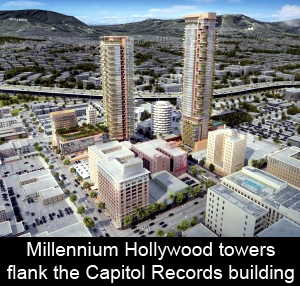 commission was given to Skidmore, Owings & Merrill. In the case of the Millennium Hollywood towers, the City Council approved the project without knowing really what the buildings were gonna look like. I find all of that shocking and surprising and unfortunate. It’s surprising in that in the first half of the 20th Century, when Los Angeles was supposedly a “cow town” without any culture, it managed to create interesting rather-idiosyncratic public buildings, such as the City Hall, the Central Library, and the Griffith planetarium. But today, when it’s supposedly become as cultured and civilized as any city — when it comes to architecture, it’s less so. I think the only interesting work, oddly enough, is in low-cost housing, both in Santa Monica and in downtown Los Angeles. Because the budgets for those buildings are low. There’s also a sense among the organizations and the institutions planning that work that it’s a matter of civic duty that poor people should have housing that is as good as that for higher-income people. The interesting architecture becomes the only way to achieve those two goals that seem contradictory. That is, making the buildings cheap to construct, but also interesting — maybe inspiring — to live in.
commission was given to Skidmore, Owings & Merrill. In the case of the Millennium Hollywood towers, the City Council approved the project without knowing really what the buildings were gonna look like. I find all of that shocking and surprising and unfortunate. It’s surprising in that in the first half of the 20th Century, when Los Angeles was supposedly a “cow town” without any culture, it managed to create interesting rather-idiosyncratic public buildings, such as the City Hall, the Central Library, and the Griffith planetarium. But today, when it’s supposedly become as cultured and civilized as any city — when it comes to architecture, it’s less so. I think the only interesting work, oddly enough, is in low-cost housing, both in Santa Monica and in downtown Los Angeles. Because the budgets for those buildings are low. There’s also a sense among the organizations and the institutions planning that work that it’s a matter of civic duty that poor people should have housing that is as good as that for higher-income people. The interesting architecture becomes the only way to achieve those two goals that seem contradictory. That is, making the buildings cheap to construct, but also interesting — maybe inspiring — to live in.
 In the ’40s, when public housing was built, the architectural ideas were completely different. They were courtyard buildings, such as the projects in East Los Angeles, like Aliso Village. They can work beautifully when there’s enough money to maintain the buildings, as you see with Village Green in Baldwin Hills. It used to be Baldwin Hills Village, and is now sought after. And I think the one project that would have involved high-rise buildings — which is one of the projects that’s including in Never Built: Los Angeles — the Elysian Heights Village, which combined highrises with courtyard apartments. It would have worked, again, had the buildings been maintained. I hope the new projects that are finally being built in Los Angeles, after many years, will work better. I mean, they’re not courtyard apartments. They’re two or three-story buildings. They’re not highrises.
In the ’40s, when public housing was built, the architectural ideas were completely different. They were courtyard buildings, such as the projects in East Los Angeles, like Aliso Village. They can work beautifully when there’s enough money to maintain the buildings, as you see with Village Green in Baldwin Hills. It used to be Baldwin Hills Village, and is now sought after. And I think the one project that would have involved high-rise buildings — which is one of the projects that’s including in Never Built: Los Angeles — the Elysian Heights Village, which combined highrises with courtyard apartments. It would have worked, again, had the buildings been maintained. I hope the new projects that are finally being built in Los Angeles, after many years, will work better. I mean, they’re not courtyard apartments. They’re two or three-story buildings. They’re not highrises.